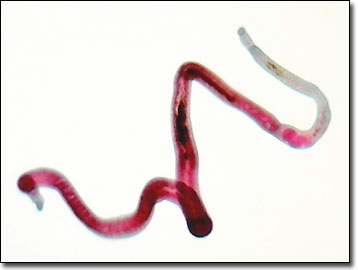Brightfield Digital Image Gallery
Human Blood Fluke (Schistosoma mansoni)
Trematode parasites in the phylum Platyhelminthes include the internationally troublesome schistosomes, which account for infections in about 200 million people in 75 tropical and sub-tropical countries. Of the three main species pathogenic to people, the human blood fluke (Schistosoma mansoni) has recently caught the imaginations of geneticists involved in the World Health Organization-sponsored Schistosome Genome Project. The goals of this ambitious project are to construct the physical map of this trematode's genome and the discovery of novel chemotherapeutic targets and vaccine candidates.

Sex-specific gene expression in S. mansoni interests some genetic parasitologists. Apparently, males can induce gene expression in females. On the molecular level, signal-transducing molecules transfer the male inductive signal to proliferating germ cells in the female's reproductive organs. Male-female pairings of Schistosoma parasites lead to the induction of female fertility (and egg formation) by the males.
Among human parasitic diseases, schistosomiasis ranks second only to malaria in terms of worldwide public health risks and socio-economic impact. Known also as bilharziasis, the disease was recognized since the time of the Egyptian pharaohs, but not isolated by its parasitic helminth until 1851 by young German pathologist, Theodor Bilharz. Acute infections, mental retardation, and even a type of bladder cancer are attributed to these intestinal trematodes. Eggs travel to and develop in the liver, bladder or intestine, and rarely to the brain and/or spinal cord, causing seizures, paralysis or meningitis.
Like the other forms of schistosomiasis, the blood flukes are carried by dirty water, placing farmers and fishermen particularly at risk. In addition to pharmaceutical treatment of infected persons, S. mansoni control through improvements in sanitation and water treatment, as well as snail control, is feasible. There is evidence that water resource development projects, such as damming of rivers, increase the prevalence of the disease as artificial shallow snail habitat is created in place of flowing waters.
The key to the life cycle, as well as control, of many forms of schistosomiasis is aquatic snails. Freshwater ecosystems become infected with eggs when infected persons urinate or defecate in the water, or when human wastes are applied as fertilizers to crops. As the eggs hatch, if certain snails are present, the parasites enter and grow. The parasite leaves the intermediate host and enters the water where it survives for approximately 48 hours unless a human host is found. The blood flukes penetrate the exposed skin of people that are wading, swimming or washing with contaminated water. Within several weeks, the parasitic nematodes grow inside the blood vessels of the host and females produce eggs. Some of the eggs reach the bladder or the large intestine, where they are then passed in the urine or stool.
Contributing Authors
Cynthia D. Kelly, Thomas J. Fellers and Michael W. Davidson - National High Magnetic Field Laboratory, 1800 East Paul Dirac Dr., The Florida State University, Tallahassee, Florida, 32310.
BACK TO THE BRIGHTFIELD IMAGE GALLERY
BACK TO THE DIGITAL IMAGE GALLERIES
Questions or comments? Send us an email.
© 1995-2025 by Michael W. Davidson and The Florida State University. All Rights Reserved. No images, graphics, software, scripts, or applets may be reproduced or used in any manner without permission from the copyright holders. Use of this website means you agree to all of the Legal Terms and Conditions set forth by the owners.
This website is maintained by our
Graphics & Web Programming Team
in collaboration with Optical Microscopy at the
National High Magnetic Field Laboratory.
Last Modification Friday, Nov 13, 2015 at 01:19 PM
Access Count Since September 17, 2002: 29799
Visit the website of our partner in introductory microscopy education:
|
|
